Reykjavik Travel Guide
Colourful, creative and charmingly offbeat, Reykjavik is the world's most northerly capital and one of its premier city break destinations. This Nordic wonderland has everything from calm open spaces to highbrow museums and a buzzing nightlife, so it's absolutely worth a visit.
The city traces its history to the late ninth century and the days of legendary Viking, Ingolfur Arnarson, who founded a settlement in southwest Iceland. He named it Reykjavik or 'Smoky Bay' after the steam rising from hot springs. Today, this source of heat and water allows Reykjavik to warm its heart without burning fuels, and the crisp, clean air is delightful.
Winters are long and bleak, though, and Reykjavik's northern latitude ensures the sun makes no more than a brief appearance every day. Despite this, the city is definitely a hot spot that's renowned for its colourful houses, striking architecture and wild nightlife, and culture lovers will find many fascinating museums. These include the Icelandic Punk Museum, which chronicles the rise of Iceland's punk music scene through artists such as Bjork and Sigur Ros, and the Saga Museum, which is often called the Viking Museum. Visitors can also bathe in steamy public geothermal swimming baths.
It's worth spending some time walking the downtown area, as its quite unique. There are eateries that serve up traditional fare such as boiled sheep's head and blood pudding, and independent boutiques sell items such as Icelandic wool clothing and volcanic rock pottery. Another must-see feature is the street-art scene. The often whimsical murals showcase aspects of Icelandic life, culture and nature.
Travellers who want a true sense of Icelandic culture should visit the Old Harbour area, which lies in the northern part of Reykjavik's historic centre. The district has a charming, traditional seafaring atmosphere that captures the authentic Iceland through vibrant-coloured, renovated fishing sheds that have been repurposed into stores, cafes and restaurants.
Reykjavik's setting on the southwest corner of Iceland is another drawcard. Panoramic views surround the majestic Mount Esja, which rises behind the bay, and vistas stretch as far as the crystalline Snaefellsjokull Glacier, which is almost 125 miles (200 km) away up the west coast. The city is well placed to be a springboard for southern Iceland, and many of the country's best-loved attractions are within easy reach.
For the most part, Reykjavik has a small-town atmosphere as its centre is easily explored on foot, and the quaint whitewashed wooden buildings and colourful houses are interspersed with plenty of open space. Even those who come to indulge mainly in the hedonistic nightlife will leave feeling refreshed and rejuvenated.
Things to do in Reykjavik
Although a beautiful, cosmopolitan and vibrant city, many of Iceland's best tourist attractions are actually located outside Reykjavik. Luckily for visitors, Iceland is a small country and none of the tourist attractions mentioned here require a significant amount of travelling to get to.
As far as attractions in Reykjavik are concerned, travellers shouldn't miss the Botanical Gardens, which are full of interesting indigenous plants and trees; the Einar Jonsson Museum, which displays works by Iceland's greatest sculptor; Hallgrimskirkja, one of the weirdest, most grandiose churches on the planet; and, to satisfy any Viking curiosity, the National Museum, Saga Museum, and the Reykjavik City Museum.
Visitors will find the real tourist gems when they enter the remarkable hinterland and, luckily, the south of the country is home to most of Iceland's top tourist attractions. Travellers should be sure to check out the Blue Lagoon, a manmade geothermal spring and spa; Geysir, the world's original hot spring; the truly transcendent Gullfoss Falls; Thingvellir National Park, with its incredible hiking trails; and Jokulsarlon, a glacial lagoon full of eerie, luminous-blue ice bergs.
No matter what travellers decide to see and do in the 'Land of Fire and Ice', one thing is for sure: they mustn't forget to take a camera along, as Iceland is a country uniquely full of sights that beggar belief. Travellers should also consider arming themselves with the Reykjavik City Card, which gives discounts on tourist attractions and restaurants, and allows unlimited bus transport.
Hallgrimskirkja
One of the tallest buildings in Iceland, this landmark church dominates the city from its highest point and is visible on a sunny day from up to 10 miles (16km) away. Named after the 17th-century Icelandic poet, hymn composer, and clergyman Hallgrimur Petursson, the church's unusual design includes volcanic basalt columns flanking its towering steeple. It took more than 40 years to build the edifice, which was finally completed in 1986. In front of the church stands a statue of Leif Eriksson, donated to Iceland by the United States. The church is lovely inside but even those uninterested in exploring this place of worship will be impressed by the striking facade. It is possible to climb the tower for views over the city.
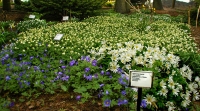
Botanical Gardens
Although Iceland is better known for its stark and rocky landscapes, a walk in Reykjavik's gardens will convince travellers of the country's more lush and flowery offerings. The pretty Reykjavik Botanic Garden is a haven for strollers, enshrining about 5,000 plant species, including a large collection of Icelandic indigenous plants and other plant collections, which give an idea of the enormous diversity of vegetation in the northern temperate zone. Besides walking trails and water features, the garden has a display greenhouse where a cosy cafe is open during the summer months. Located close to the garden is the Reykjavik Zoo and Family Park. The gardens are open all year round, though opening times may vary season to season and there is less to see in the colder months. Admission is free.
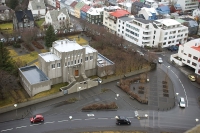
Einar Jónsson Museum
Einar Jonsson was Iceland's foremost sculptor, and designed and established the Einar Jonsson Museum himself. It contains over 300 of the pieces he did over his 60-year career, and it served as his home, gallery and studio. The building itself is deemed to be Jonsson's largest work, with the foundation stone laid in 1916. Iceland's first art museum, it retains pride of place on the highest point in Reykjavik. It is adjoined by a pristine and leafy sculpture garden that sports about 26 bronze casts of the artist's work. There is also a museum shop selling plaster casts of Jonsson's works, books and postcards. Travellers should note that the museum is closed on Mondays and for the whole of January and February. All other admission details can be found on the official website listed below.
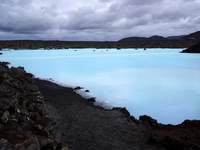
Blue Lagoon
Located about 30 miles (50km) southwest of Reykjavik, the manmade geothermal Blue Lagoon is a favourite and unique attraction. It's set in a lava field and is filled with mineral-rich hot water pumped from about a mile below the surface. The lagoon is flanked by a luxurious health spa where visitors come to be pampered and treated for skin ailments such as eczema and psoriasis. The lagoon's surreal phosphorescent aquamarine colour is caused by the therapeutic ecosystem of algae, silica, and minerals in the water. Visitors should note that the Blue Lagoon is very popular and should be booked as far in advance as possible to avoid disappointment. The opening times change seasonally and can be found on the website listed below.
Gullfoss Falls
Iceland's famed Gullfoss (Golden) Falls are justly rated among the most beautiful in the world, and make for a popular excursion from Reykjavik. The falls, with their awesome double-cascade, are incredibly powerful, which has meant they have come under threat of being utilised as a source of hydro-electricity. Currently, however, the magnificent natural water feature, shrouded in mist and rainbows and gushing into a canyon on the Hvita River, is safely ensconced in a national park and remains one of the country's top tourist attractions. The falls can be visited on Iceland's famous Golden Circle route, and many tour operators and public buses make daily trips to the national park during the warmer months.
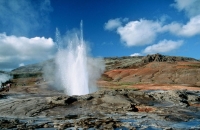
Geysir
The weird landscape of the Haukadalur Valley in the southern lowlands of Iceland has been dominated for centuries by the Great Geysir. It's from here that all other such phenomena around the world have gained their name. The geyser once shot boiling water hundreds of feet into the air, but the height of the eruption has reduced in modern times. Nevertheless, it's still an impressive sight. The rest of the thermal area, bathed in a sulphuric smell, is just as fascinating, featuring several other spouting vents and geysers that frequently display their prowess. The Great Geysir has become a very popular tourist attraction, and a centre has been opened containing a multimedia geology museum and folklore exhibits. There is also a hotel, souvenir shop, and restaurant on site.
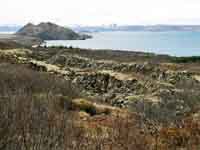
Thingvellir National Park
The national park of Thingvellir lies 30 miles (50km) east of Reykjavik and is not only Iceland's most important historic site, but also a place of natural and geological wonder. It was here that the world's first-ever parliament, the Alting, initially convened in AD 930, and where Christianity was first introduced to Iceland. Even today, people gather at Thingvellir to celebrate any major national events.
Geologically, this is the only site in the world where the American and European tectonic plates are visible. The park is also home to the largest lake in Iceland, and stunning scenery including a lava gorge, the Oxararfoss Waterfall, and the Money Chasm, where visitors drop coins down a gorge into water, to witness the strange distorted reflections that result.
Activities available at Thingvellir National Park include hiking, angling, horseback riding, diving, and camping. The national park is open all year and, in the warmer months, a daily bus visits the park from Reykjavik.
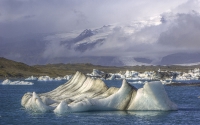
Jökulsárlón
Jokulsarlon (glacier lagoon) is the largest glacial lake in Iceland, and an enormously popular tourist attraction. The site shot to prominence after being featured in Hollywood movies (most memorably, Batman Begins), and now attracts thousands of visitors each year.
Caused by the retreat of the glacier known as Breidamerkurjokull, the lagoon is now nearly a mile (1.5km) from the ocean's edge, and is over 814 feet (248m) deep. Most easily approached from the fishing town of Hofn on Iceland's southern coast, visitors in search of an indelible memory of their time in the country should definitely make the trip to Jokulsarlon, where luminous blue icebergs float eerily across the freezing water.
Whatever visitors do, they shouldn't forget to pack a camera. Jokulsarlon is undoubtedly one of the best sights Iceland has to offer, and in such a staggeringly beautiful country, that's really saying something.
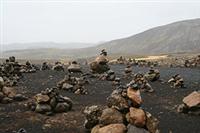
Hidden People
One of the most interesting cultural drawcards of Iceland must surely be the Huldufolk ('Hidden People'). In Icelandic folklore, the Huldufolk are magical invisible beings who can appear at will. Also called elves, they can be observed by humans with a talent for communicating with the hidden realm.
While not many of Iceland's population believe in the Huldufolk, they remain an important element of the country's folklore and national identity. Visitors to Iceland who learn about the Hidden People will gain a lot of insight into local culture.
Recommended Huldufolk-related activities include a visit to Reykjavik's Hellisgerdi Lava Park (which is supposedly full of elven homes); a trip to the Museum of Icelandic Wonders in Stokkseyri, which is just 37 miles (60km) from the capital; and, for the really enthusiastic, a half-day course at Magnus Skarphedinsson's Alfaskolinn, the Icelandic Elf School, where visitors learn all about their world and even receive a diploma to prove it.
Eating Out
Although the national diet is quickly diversifying, fish and lamb are still consumed in great quantities in Iceland, and some say it can be quite hard to find a vegetarian option on restaurant menus. Despite this, Reykjavik's restaurant scene is exciting and becoming increasingly cosmopolitan as restaurateurs attempt to offer fresh interpretations of international dishes using local ingredients.
Traditional fare, available everywhere but probably only tempting for the more gastronomically adventurous, includes harðfiskur (dried fish-meat, eaten with butter); svið (singed sheep's head); slátur (sausage made from blood and offal, such as black pudding); hrútspungar (pickled ram's testicles); and hákarl (putrefied shark-meat).
There is also, controversially for some, the option of eating whale-meat while in Iceland. And if visitors really want to push the boat out, they can order it with some grated puffin on the side. Those with tamer appetites will be relieved to know that a staple of the Icelandic diet is the pylsa, a good, old-fashioned hot dog, served with fried onions, ketchup, and mustard.
Nightlife
There may be limited sunlight in the northern city of Reykjavik, but the locals here really know how to make good use of those long, cold, and dark winter nights. The bright lights of the bars and clubs that line the streets will blow visitors away, and they can heat things up even more on the dance floor.
Due to the high cost of alcohol, the nightlife only gets going very late, as most Icelanders tend to have a few drinks at home before hitting the town. Travellers arriving in Reykjavik by air should not pass up the opportunity to buy cheap alcohol in the duty free store at the airport.
Once sufficiently warmed up for the night, travellers can head to trendy Laugavegur, where most of Reykjavik's 100 or so bars and clubs are located, dotted around the strip and its side streets. On busy Friday and Saturday nights, it's not uncommon for the street to be filled with people all night long. On a side note, the drinking age in Iceland is 20.
Getting Around
The best way to travel around Reykjavik is on the excellent bus service that covers downtown and the outer suburbs from the central terminals at Hlemmur and Laekjartorg. Buses run from around 7am to 11pm on weekdays and less frequently on weekends. Passengers should pay the exact fare to drivers, as they are not permitted to give change. Bicycles are an extremely popular form of transport and the city has a network of cycle lanes. Car hire is recommended as there is little traffic congestion and local drivers are typically considerate. The Hreyfill taxi app is another option.
Reykjavik Climate and Weather
Despite its extreme north Atlantic location, Reykjavik's temperate sub-polar oceanic climate is not as cold as might be expected. Its average mid-winter temperatures are, in fact, no lower than those in New York City. Winter temperatures average between 28ºF (-2ºC) and 38ºF (3ºC). This is because the Icelandic coastal weather is tempered by the warm waters of the Gulf Stream. The city's coastal position does, however, also mean it is prone to wind, and gales are common in winter. Summer temperatures in July, the warmest month, peak at around 59ºF (15ºC).
Iceland travel info
Electricity
Iceland's electricity supply is 230 volts, 50Hz, as it is in most European countries. Plugs and sockets are of the two-pin type typical of Europe.
Language
Icelandic, but English is widely spoken.
Money
The unit of currency is the Icelandic kronur (ISK). Almost all banks offer foreign exchange facilities and can be found in even the tiniest villages. Most have ATMs on their premises and they're available after banking hours, which are usually Monday to Friday from 9.15am to 4pm. Credit cards are widely used in Iceland for purchases and cash advances.
Tipping
Service charges are included in bills and tipping is not expected in Iceland.
Health
There are no specific health risks associated with travel to Iceland, and no vaccinations are necessary for entry. Travellers should, as a precaution, be up-to-date on routine vaccinations before every trip, and should consider getting vaccinated for hepatitis A and hepatitis B. Medical care in the country is of high quality and payment is usually expected in cash from visitors. Travel health insurance is highly recommended.
Safety
Iceland is an extremely safe country to visit. The only threats are a low level of petty crime and the odd instance of antisocial behaviour, which can occur around the bars in downtown Reykjavík. Visitors should take sensible precautions and keep their belongings safe.
Anyone visiting Iceland for hiking or mountaineering should choose a hike that's suitable for their level of experience. They should also pack a map, compass, GPS and phone, as well as extra clothing and emergency supplies of food, water and equipment. Visitors who head into the wilderness should leave a copy of their travel itinerary with a third party such as their hotel or the website Safe Travel Iceland.
It's best not to get too close to the ocean, cliff edges and hot springs, as that is the most common cause of accidents in Iceland.
Local customs
Smoking in bars, restaurants and on public transport is illegal in Iceland, and penalties for the possession of drugs are steep. Travellers should note that although whale meat is legally available in Iceland, it is not legal to bring it across borders into the UK or EU.
Doing business
Most business in Iceland tends to take place in the capital, Reykjavik, and business meetings are usually formal with smart dress essential. It's worth handing out business cards, and initial greetings are usually accompanied by a handshake. Punctuality should be respected; meetings are usually conducted in English when dealing with foreigners. Visiting business people should note that Icelanders generally go by their first name, and telephone directory listings are alphabetical by first name. Business hours are usually from 8am to 4pm (summer) and 9am to 5pm (winter); most offices are closed on weekends.
Duty free
Travellers to Iceland over 18 years do not have to pay duty on 200 cigarettes or 250g of other tobacco products. Travellers over 20 years are also allowed 1 litre of spirits and 3 litres of beer, or 3 litres of wine and 6 litres beer, or 1 litre spirits and 6 litres beer, or 1.5 litres of wine and a 12 litres of beer, or 18 litres of beer; and food items up to 3 kg not exceeding ISK 25,000. Permits from Post & Telecom Authorities are required for cordless phones, remote controls or radio transmitters, but not for a GSM mobile phone. Prohibited items include narcotics and drugs, uncooked meat products, weapons and powdered or moist snuff.
Communications
The international country code for Iceland is +354. Travellers should note that Icelanders are listed by their first name in the telephone directory, not the last. Visitors can rent WiFi hotspots; WiFi is easy to access and free calls can be made using WiFi connections.
Passport & Visa
The borderless region known as the Schengen Area includes Austria, Belgium, Czech Republic, Denmark, Estonia, Finland, France, Germany, Greece, Hungary, Iceland, Italy, Latvia, Lithuania, Luxembourg, Malta, The Netherlands, Norway, Poland, Portugal, Slovakia, Slovenia, Spain, Sweden and Switzerland. All of these countries issue a standard Schengen visa that has a multiple entry option, and which allows the holder to travel freely within the borders of all the aforementioned countries. Additionally, foreign passengers to Iceland must hold return or onward tickets, the necessary travel documentation for their next destination, and sufficient funds to cover their stay in Iceland. It is highly recommended that travellers' passports have at least six months' validity remaining after the intended date of departure from their travel destination. Immigration officials often apply different rules to those stated by travel agents and official sources.
Entry requirements
US citizens must have a passport that is valid for at least three months beyond the date of departure from the Schengen Area. No visa is required for stays of up to 90 days within a 180‑day period.
UK citizens must have a passport that was issued within the past 10 years and is valid for at least three months beyond the date of departure from the Schengen Area. No visa is required for stays of up to 90 days within a 180‑day period.
Canadian citizens must have a passport that is valid for at least three months beyond the date of departure from the Schengen Area. No visa is required for stays of up to 90 days within a 180‑day period.
Australian citizens must have a passport that was issued within the past 10 years and is valid for at least three months beyond the date of departure from the Schengen Area. No visa is required for stays of up to 90 days within a 180‑day period.
South African citizens must have a passport that was issued within the past 10 years and is valid for at least three months beyond the date of departure from the Schengen Area. A valid Schengen visa is required prior to arrival.
Irish citizens must have a passport that is valid for the duration of their stay in Iceland. No visa is required.
New Zealand citizens must have a passport that is valid for at least three months beyond the date of departure from the Schengen Area. No visa is required for stays of up to 90 days within a 180‑day period.
Useful contacts
Reykjavik Tourist Information Centre, Reykjavik: +354 454 2000 or www.reykjaviktouristinfo.is
112 (General)


